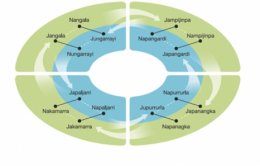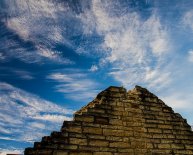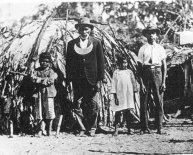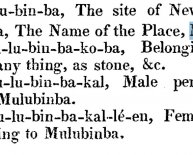
Names of Aboriginal tribes

Kinship is at the heart of Indigenous society. A person’s position in the kinship system establishes their relationship to others and to the universe, prescribing their responsibilities towards other people, the land and natural resources. Traditional kinship structures remain important in many Aboriginal communities today.¹
There are over 500 Aboriginal nations across Australia. Aboriginal nations cover wide geographical areas, and have distinct borders. Within these nations there are clan groups, and within the clan groups there are family groups. Clan groups share a common language and kinship system, which is based on either patrilineal or matrilineal lines of descent.² There are three levels of kinship in Indigenous society: Moiety, Totem and Skin Names.
Moiety
The first level of kinship is Moiety. Moiety is a latin word meaning ‘half’. In Moiety systems, everything, including people and the environment, are split into two halves. Each half is a mirror of the other, and to understand the whole universe these two halves must come together.
A person's Moiety can be determined by their mother's side (matrilineal) or their father's side (patrilineal). Moieties can also alternate between each generation (people of alternate generations are grouped together).³
People who share the same Moiety are considered siblings, meaning they are forbidden to marry. They also have a reciprocal responsibility to support each other (4).
Each nation and language has its own term for Moiety. For example, the Yolngu people of north-eastern Arnhem Land are either Dhuwa or Yirritja. In the Yolngu worldview, ancestral beings assigned everything in the universe to either the Dhuwa or the Yirritja Moiety. For example, the black cockatoo is Dhuwa, while the white cockatoo is Yirritja. The two Moieties complement and balance each other; in ceremonies, marriage, and daily life.
Warlpiri (Central Desert) kinship diagram by Graham PaulsonTotems
The second level of kinship is Totem. Each person has at least four Totems which represent their nation, clan and family group, as well as a personal Totem. Nation, clan and family Totems are preordained, whereas personal Totems recognise an individual’s strengths and weaknesses.
Totems link a person to the universe - to land, air, water and geographical features. People don’t ‘own’ their Totems, rather they are accountable for them. Each person has a responsibility to ensure that their Totems are protected and passed on to the next generation.
Totems are split between Moieties to create a balance of use and protection. For example, while members of one Moiety protect and conserve the animal, members of the other Moiety may eat and use the animal (5).
Skin Names
The third level of kinship is the Skin Name. Similar to a surname, a Skin Name indicates a person’s blood line. It also conveys information about how generations are linked and how they should interact. Unlike surnames, husbands and wives don’t share the same Skin Name, and children don’t share their parents’ name. Rather, it is a sequential system, so Skin Names are given based on the preceding name (the mother’s name in a matrilineal system or the father’s name in a patrilineal system) and its level in the naming cycle. Each nation has its own Skin Names and each name has a prefix or suffix to indicate gender. There are 16-32 sets of names in each cycle.
For example, in a matrilineal nation, if a woman with the first name in the cycle (One) has a baby, the child’s Skin Name will be the second name in the cycle (Two). All other ‘Twos’ in that community are now considered the sibling of that child, and all ‘Ones’ are considered their parents. When that child grows up and has children of their own, those children will be Threes. This sequential naming continues until the end of the number cycle is reached, then it begins again at One (6).

















